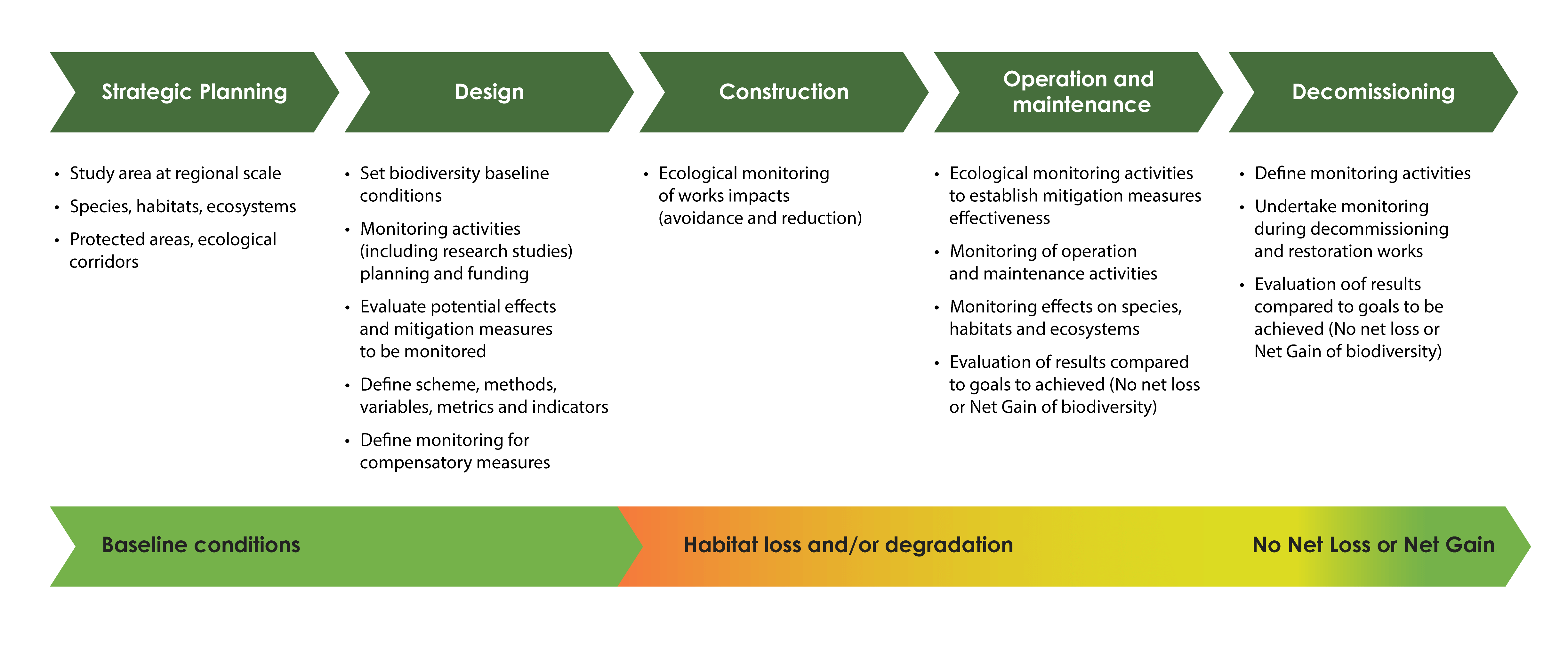Planning and preparing an appropriate monitoring plan should take place throughout the successive phases of the project, from the design, construction and operation phases to decommissioning (Figure 6.2.2. and see Chapter 2 – Policy, strategy and planning).
Design phase: the monitoring plan is usually established in the early design phase and sometimes at the end of the strategic planning phase (see Chapter 2 – Policy, strategy and planning), identifying at this point the main biodiversity elements to be monitored and evaluated in the framework of the EIA process. Monitoring plans should be designed as soon as possible during the infrastructure planning phase to facilitate its implementation in later phases. This is especially the case for research studies, which should be prepared as soon as possible, and sufficient funds should be allocated to monitor and collect the data needed before construction begins. Studies should start with robust wildlife inventories that provide accurate lists of species, their distribution and population dynamics when possible, and maps of habitats including information about their conservation status. Wildlife inventories are therefore a key tool to start designing monitoring plans. They provide key information to prioritise focal species and habitats, identify sites to be avoided for infrastructure projects, and help to establish the mitigation measures needs. Inventories consisting of information on fauna, flora, and habitats must be carried out to determine the status of a population or a habitat and its distribution and to establish the biodiversity baseline. This type of study is undertaken during the SEA and -more detailed- during the EIA process. It should be the first step in monitoring, before any intervention is undertaken. The monitoring plan is then adapted, where necessary, according to newly found species and habitats. This initial biodiversity baseline data informs the definition of variables, metrics and indicators to be applied from the construction to the operation phase, to adequately monitor the effectiveness of mitigation measures as soon as they are implemented and operational.
Construction phase: monitoring activities are undertaken during works to ensure impacts on species and habitats adjacent to construction sites are avoided and appropriate construction mitigation measures are applied. Scheduling of the works is a crucial aspect to be monitored to avoid impacts during particularly vulnerable periods (e.g., breeding seasons).
Operation and maintenance: monitoring and evaluation of the effectiveness of mitigation measures must take place alongside with rapid corrective actions to ensure deficiencies in functioning are corrected (e.g., repairing a hole in a fence to prevent access of animals to the carriageway). Long-term monitoring, sometimes lasting a decade or longer, may also be necessary to measure appropriately some of the effects caused by the infrastructure on biodiversity, and, if needed, inform the competent authorities on the need to apply further mitigating solutions (e.g., problematic levels of roadkill registered through surveys conducted by maintenance patrols could help to identify hotspots of road mortality and undertake actions to reduce it).
Decommissioning phase: in some cases when the infrastructure is no longer required, specific evaluation of the impacts of demolition and restoration must be undertaken (in the framework of an EIA process if required). Appropriate monitoring of restoration during works and for an established period, usually of 5-10 years, to monitor the progress of restored land are crucial.
Upgrading of transport infrastructure: in cases of major works aimed to enlarge or adapt the infrastructure to enhance its resilience this may be considered as the equivalent of a new project, thus requiring the design of a monitoring plan similar to that described above for new infrastructure.
